
Thirteen years after its Broadway premiere, Jason Robert Brown and Alfred Uhry’s Tony-winning musical Parade at long last gets its first San Diego production—one so superbly staged and performed that it more than justifies a day trip to our neighbor to the South.
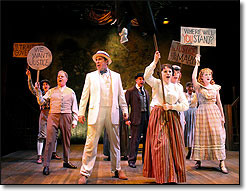
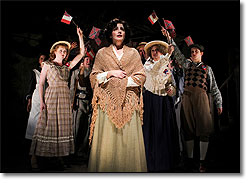 Parade takes as its subject the 1915 lynching of Jewish Northerner Leo Frank, falsely convicted of murdering 13-year-old Georgia factory worker Mary Phagan, a hate crime that remains today, nearly a century later, one of the most horrendous miscarriages of justice in United States history. No wonder the musical (with songs by Brown and book by Uhry) was a hard sell even on Broadway. If Fosse was the “feel-good” musical of 1999, then a show with such grim subject matter as Parade was pretty much its antithesis, and closed after 85 performances.
Parade takes as its subject the 1915 lynching of Jewish Northerner Leo Frank, falsely convicted of murdering 13-year-old Georgia factory worker Mary Phagan, a hate crime that remains today, nearly a century later, one of the most horrendous miscarriages of justice in United States history. No wonder the musical (with songs by Brown and book by Uhry) was a hard sell even on Broadway. If Fosse was the “feel-good” musical of 1999, then a show with such grim subject matter as Parade was pretty much its antithesis, and closed after 85 performances.
Still, Parade snagged Tony Awards for both of its creators. Composer Brown won for Best Score, a powerful, eclectic collection of songs which run the gamut from gospel to pop rock to rhythm and blues to emotional ballads. Likewise, no one writes with more insight about being Jewish in the South than Uhry, whose book proves the playwright as adept at drama as Driving Miss Daisy and The Last Night Of Ballyhoo proved him at comedy. Uhry’s book moves back and forth through time, as flashbacks reveal the events leading up to Frank’s arrest and trial and we meet the musical’s many characters, each of whom played an important role in the case and each of whom gets his or her center-stage moment to shine.
In a powerful prologue, a young confederate soldier (Jacob Caltrider) sings a hymn to Georgia, “The Old Red Hills Of Home,” morphing into his elderly self (Steve Gunderson), a reminder that the Civil War was not a distant memory at the time of Frank’s trial, but a very real one for the citizens of Atlanta.
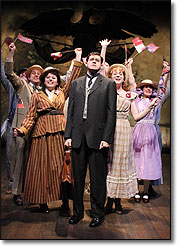
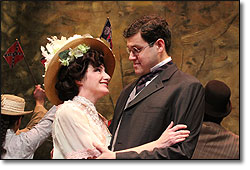 Young Frankie Epps (Caltrider) invites pencil factory worker Mary Phagan (Samantha Littleford) to “The Picture Show,” but Mary never arrives. Since we have just seen her visit the office of factory manager Leo (Brandon Joel Maier) to get her meager week’s wages in a scene that Parade’s book cuts deliberately short, it is left to us (and to the citizens of Marietta) to fill in the blanks, though in markedly different ways.
Young Frankie Epps (Caltrider) invites pencil factory worker Mary Phagan (Samantha Littleford) to “The Picture Show,” but Mary never arrives. Since we have just seen her visit the office of factory manager Leo (Brandon Joel Maier) to get her meager week’s wages in a scene that Parade’s book cuts deliberately short, it is left to us (and to the citizens of Marietta) to fill in the blanks, though in markedly different ways.
Evidence soon piles up against Leo, much of it coming from janitor Jim Conley (Brian Barbarin), damning evidence that ultimately leads to his arrest for murder and the kangaroo court that was his trial. Meanwhile, Leo’s mouse of a Southern Jewish wife Lucille (Sandy Campbell) informs her flabbergasted husband of her intention to leave town during his trial, a decision whose ultimate reversal is merely the first step in Lucille’s transformation from cowardice to courage.
In court, prosecutor Hugh Dorsey (David Kirk Grant) interrogates a trio of factory girls (Kathleen Calvin, Amy Perkins, and Katie Whalley), who testify under oath that Leo had invited Mary to “Come Up To My Office,” incriminating evidence accompanied by a fantasy ballet vividly depicting the sex fiend the townfolk of Marietta believe Leo to be. Mary’s mother (Briona Daugherty) then takes the stand with the devastating “My Child Will Forgive Me,” after which, in a show-stoppingly jazzy “That’s What He Said,” Conley concocts the elaborate lie that seals Frank’s fate.
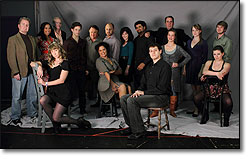
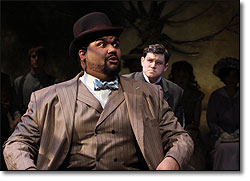 Broadway’s Parade featured a cast of 27, later cut down to 15 for a scaled-down London revival that played L.A.’s Mark Taper Forum in 2009. While beautifully performed, that reduced-cast version lacked the scope of the original. Not only was the absence of the Marietta populace palpable, the casting of individual actors in as many as three different roles proved jarring to the point of confusion.
Broadway’s Parade featured a cast of 27, later cut down to 15 for a scaled-down London revival that played L.A.’s Mark Taper Forum in 2009. While beautifully performed, that reduced-cast version lacked the scope of the original. Not only was the absence of the Marietta populace palpable, the casting of individual actors in as many as three different roles proved jarring to the point of confusion.
Cygnet Artistic Director Murray finds inspired solutions to the above problems.
For one thing, Murray keeps much of the cast onstage throughout, a more surreal approach than the Taper’s, but one that makes us constantly aware of Marietta’s headline-devouring, finger-pointing citizenry and even brings Mary’s ghost back at several pivotal moments. This less realistic tone also makes it easier to buy that, for example, a single actor is bringing to life characters as diverse as reporter Britt Craig, Georgia Governor Slaton, and the prison guard Lucille bribes into letting her into Leo’s cell. Only in one case did this reviewer fail to realize that the factory worker first arrested by the police was not the same one whose testimony later proves so damning to Leo.
The cast onstage at Cygnet could not be better. Barbarin brings his gorgeous, booming bass to factory workers Newt and Jim, and is matched by Caltrider’s glorious tenor in a pair of roles. Geno Carr’s sales-hungry newspaper editor, Daughtery’s grieving mother, and Gunderson’s Judge Roan are all beautifully delineated, as are their other characters. Grant does his accustomed fine work as the trial’s relentless prosecutor as does Tom Stephenson in multiple roles. Meads is a standout as the aforementioned reporter, Governor, and guard. Calvin, Perkins, and Whalley create vivid portraits of three frightened, easily influenced factory girls, and Gigi Coddington makes a strong impression as the Franks’ maid Minnie. San Diego teens Dylan Hoffinger and Littleford reveal talent and promise in their supporting roles.
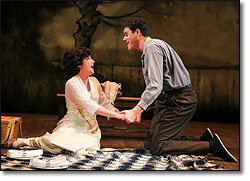
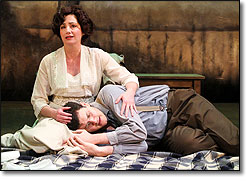 Still, there would be no Parade without Leo and Lucille, roles for which their Broadway originators Brent Carver and Carolee Carmello won Tony awards, and Cygnet’s Maier and Campbell are, in a word, superb.
Still, there would be no Parade without Leo and Lucille, roles for which their Broadway originators Brent Carver and Carolee Carmello won Tony awards, and Cygnet’s Maier and Campbell are, in a word, superb.
Maier is a towering presence as Leo, both physically and emotionally. In early scenes, the actor’s height makes Leo’s “otherness” among the Georgians around him all the more noticeable. Much of the brilliance of Maier’s performance is in the details, like the way he sits in court, arms and legs crossed so as to suggest either defiance or boredom—or a combination of both. As Leo begins to face the very real possibility that his trial may end in the death penalty, Maier’s performance achieves a transcendent nobility. Vocally, he is superb.
San Diego treasure Campbell’s petite stature also works in her favor, helping us to believe in the painful self-consciousness that makes Lucille want to flee Marietta at the very hour of her husband’s greatest need. Later, as Lucille gains strength and courage, Campbell too seems to grow, if not in physical stature, than in its emotional equivalent, reminding us that Parade is also the story of a woman’s journey from fear to valor. In their final, exquisitely sung duet, Maier and Campbell make us realize we are seeing one of the great love stories of the 20th Century.
Murray’s surreal approach to staging Parade means not only that his cast is onstage more often than Uhry’s book might indicate, it gives choreographer David Brannen particularly ample opportunities to integrate movement and dance throughout the evening, and not just in the show’s more traditional dance numbers like Act Two’s “Pretty Music” two-step. The trolley riders that accompany Frankie and Mary to the “Picture Show” are just one example of Brannen’s ingenuity.
Musical director Billy Thompson does masterful work with the cast’s vocal performances along with conducting the production’s outstanding eight-piece orchestra.
Designwise, this is one gorgeous-to-look-at production, Cygnet Theatre’s Old Town architecture a perfect fit with Sean Fanning’s imaginative set design. Fanning’s design is backed by lead scenic painter Jessica Harriman’s beautiful backdrop painting and complemented by Bonnie L. Durben’s numerous period props. Ross Goldman’s sound design insures a just-right mix of voices and instruments. Shirley Pierson’s costumes and Peter Herman’s wig and makeup are both 1910s perfect. Chris Rynne’s vivid lighting design is as good as it gets, and never more so than when he transforms Leo’s jail cell into a grassy meadow all with the flick of a switch.
Rosalee Barrientos is stage manager, assisted by Marie Jahelka. Alana Anthony is assistant costume designer, Michael Czech audio mixer, and Megan Fonseca lighting design assistant. Annie Hinton is dialect coach.
I’ve seen Parade three times before, but never done quite as perfectly as at Cygnet. Director Murray adds two inspired bits to the play’s final moments, one involving Jim Conley and one Lucille, that made me catch my breath. Parade may not have you exiting the theater with the kind of big, broad smile on your face that, say, Hairspray is guaranteed to produce, but you will leave inspired by the power of musical theater to move and to transform.
Cygnet Theatre, 4040 Twiggs St., San Diego.
www.cygnettheatre.com
–Steven Stanley
March 17, 2012
Photos: Daren Scott


 Since 2007, Steven Stanley's StageSceneLA.com has spotlighted the best in Southern California theater via reviews, interviews, and its annual StageSceneLA Scenies.
Since 2007, Steven Stanley's StageSceneLA.com has spotlighted the best in Southern California theater via reviews, interviews, and its annual StageSceneLA Scenies.







 COPYRIGHT 2024 STEVEN STANLEY :: DESIGN BY
COPYRIGHT 2024 STEVEN STANLEY :: DESIGN BY